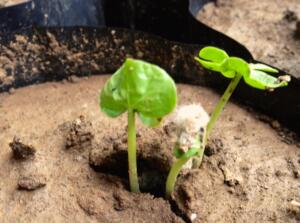
※ The image shows the fourth day after the seed was sown. The white appearance in the center of the twin leaves is the epidermis of the seed, which still has cotton fibers like laying hairs.
I had half given up, thinking that they would probably not germinate, but the native seeds from the Mikawa region have germinated. We delivered the seeds to Mr. Kruta's field near the Thai border, but it was too far away, so we decided to try sowing the seeds in 50 pots in the suburbs of Battambang City and check the germination rate. The result was more than 90% germination. I do not know what will happen after this, but the vivid green twin leaves came to life as if nothing had happened, even in an environment with a completely different climate. I am happy.
It is said that cotton seeds were brought to Japan in 799. It was first introduced to Japan by the Koronjin (presumed to be Indians today) who drifted ashore on a ship in Tenjiku Village, Hazu County, Mikawa Province (present-day Nishio City, Aichi Prefecture).
In Japan, cotton seeds once ceased to exist, but records indicate that they were introduced again in the 1550s from Ryukyu (present-day Okinawa). In the Mikawa region, it is believed that since that time, native cotton seeds have been passed down from generation to generation, collected by private farmers.
I couldn't help but think, "Seeds are so mysterious," as I watched them germinate vigorously in the shade of the palm tree. I was surprised at their ability to adapt to the environment, which is natural for a seed to do so, as it must produce offspring at any cost.
I am watching over the native species in the mountainous areas of Thailand and the native species in the Mikawa region by feeding them with fertilizer made from rice husks, feeling that they must have "something" that is beyond human knowledge in the 4-billion-year history of life.
